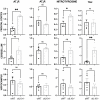Losartan Mitigates Oxidative Stress in the Brains of Aged and Inflamed IL-10-/- Mice
- PMID: 35486382
- PMCID: PMC9434460
- DOI: 10.1093/gerona/glac101
Losartan Mitigates Oxidative Stress in the Brains of Aged and Inflamed IL-10-/- Mice
Abstract
Chronic inflammation, oxidative stress, and dysregulation of the renin-angiotensin system are closely linked, and their crosstalk commonly contributes to age-related physical and cognitive decline. The primary dementia-protective benefits of Angiotensin II type 1 receptor (AT1R) blockers are believed to arise from systemic effects on blood pressure. However, there is an independently regulated brain-specific renin-angiotensin system. Here, we examined the impact of 4 weeks of oral Losartan treatment on the brains of aged (100 weeks old) IL-10-/- mice, an animal model of chronic inflammation and frailty. Our data show that aged IL-10-/- mice have higher AT1R and Nitrotyrosine (oxidative stress marker) levels in their frontal cortex tissue but not in cerebellar or hippocampal tissue compared to age- and sex-matched wild type mice. Losartan treatment for 4 weeks is associated with lower AT1R protein level, Nitrotyrosine, and Tau protein in the frontal cortex of aged IL-10-/- mice. Our results highlight the impact of Losartan, an AT1R blocker commonly prescribed for treating high blood pressure, on the brain-specific angiotensin system and AT1R-linked downstream effects such as brain oxidative stress damage and Tau burden in a frailty mouse model.
Keywords: Angiotensin system; Brain; Inflammation; Losartan; Tau.
© The Author(s) 2022. Published by Oxford University Press on behalf of The Gerontological Society of America. All rights reserved. For permissions, please e-mail: journals.permissions@oup.com.
Figures



Similar articles
-
Role of Angiotensin II type 1 receptor on renal NAD(P)H oxidase, oxidative stress and inflammation in nitric oxide inhibition induced-hypertension.Life Sci. 2015 Mar 1;124:81-90. doi: 10.1016/j.lfs.2015.01.005. Epub 2015 Jan 24. Life Sci. 2015. PMID: 25623850 Free PMC article.
-
Losartan improves measures of activity, inflammation, and oxidative stress in older mice.Exp Gerontol. 2014 Oct;58:174-8. doi: 10.1016/j.exger.2014.07.017. Epub 2014 Jul 28. Exp Gerontol. 2014. PMID: 25077714 Free PMC article.
-
The angiotensin receptor blocker, Losartan, inhibits mammary tumor development and progression to invasive carcinoma.Oncotarget. 2017 Mar 21;8(12):18640-18656. doi: 10.18632/oncotarget.15553. Oncotarget. 2017. PMID: 28416734 Free PMC article.
-
Reversal of Aortic Enlargement Induced by Increased Biomechanical Forces Requires AT1R Inhibition in Conjunction With AT2R Activation.Arterioscler Thromb Vasc Biol. 2019 Mar;39(3):459-466. doi: 10.1161/ATVBAHA.118.312158. Arterioscler Thromb Vasc Biol. 2019. PMID: 30602301 Free PMC article.
-
Angiotensin 2 type 1 receptor blockade different affects postishemic kidney injury in normotensive and hypertensive rats.J Physiol Biochem. 2016 Dec;72(4):813-820. doi: 10.1007/s13105-016-0514-4. Epub 2016 Aug 18. J Physiol Biochem. 2016. PMID: 27534651 Review.
Cited by
-
Modulator Effect of AT1 Receptor Knockdown on THP-1 Macrophage Proinflammatory Activity.Biology (Basel). 2024 May 26;13(6):382. doi: 10.3390/biology13060382. Biology (Basel). 2024. PMID: 38927262 Free PMC article.
-
Nrf2-Keap1 in Cardiovascular Disease: Which Is the Cart and Which the Horse?Physiology (Bethesda). 2024 Sep 1;39(5):0. doi: 10.1152/physiol.00015.2024. Epub 2024 Apr 30. Physiology (Bethesda). 2024. PMID: 38687468 Review.
-
The Crucial Role of the Blood-Brain Barrier in Neurodegenerative Diseases: Mechanisms of Disruption and Therapeutic Implications.J Clin Med. 2025 Jan 9;14(2):386. doi: 10.3390/jcm14020386. J Clin Med. 2025. PMID: 39860392 Free PMC article. Review.

